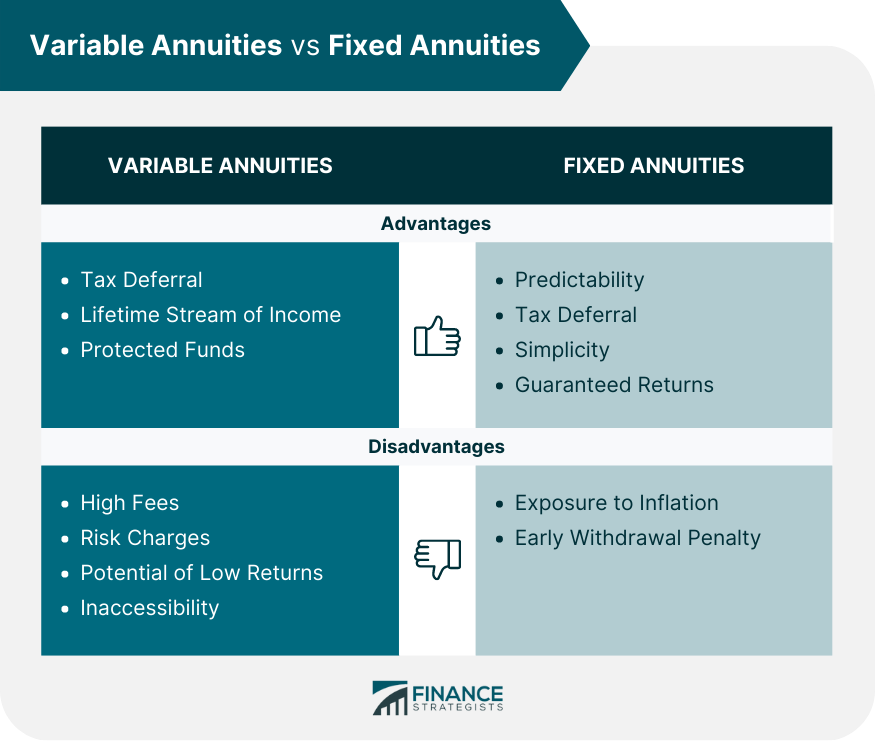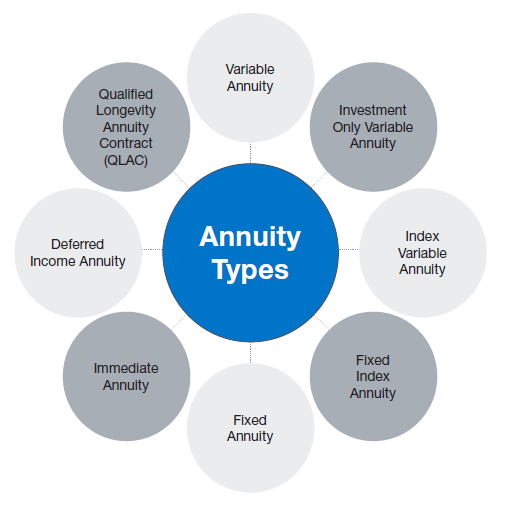All Categories
Featured
Table of Contents
There are 3 types of annuities: dealt with, variable and indexed. With a repaired annuity, the insurance coverage business ensures both the rate of return (the rate of interest rate) and the payment to the investor.
With a deferred fixed annuity, the insurance firm concurs to pay you no much less than a defined interest rate throughout the time that your account is growing. With an instant set annuityor when you "annuitize" your postponed annuityyou obtain an established fixed amount of cash, normally on a regular monthly basis (comparable to a pension).
While a variable annuity has the advantage of tax-deferred development, its annual expenditures are most likely to be much greater than the expenses of a normal mutual fund. And, unlike a taken care of annuity, variable annuities do not provide any type of warranty that you'll earn a return on your investment. Rather, there's a threat that you could really shed money.
Understanding Financial Strategies A Comprehensive Guide to Investment Choices Defining Fixed Index Annuity Vs Variable Annuities Features of Smart Investment Choices Why Choosing the Right Financial Strategy Is Worth Considering How to Compare Different Investment Plans: How It Works Key Differences Between Different Financial Strategies Understanding the Risks of Long-Term Investments Who Should Consider Deferred Annuity Vs Variable Annuity? Tips for Choosing Fixed Vs Variable Annuity Pros Cons FAQs About Planning Your Financial Future Common Mistakes to Avoid When Planning Your Retirement Financial Planning Simplified: Understanding Your Options A Beginner’s Guide to Smart Investment Decisions A Closer Look at How to Build a Retirement Plan
Because of the intricacy of variable annuities, they're a leading source of investor complaints to FINRA. Prior to getting a variable annuity, very carefully reviewed the annuity's syllabus, and ask the individual offering the annuity to explain all of the product's attributes, cyclists, costs and constraints. You should likewise know exactly how your broker is being made up, including whether they're getting a payment and, if so, just how much.
Indexed annuities are complex financial tools that have qualities of both repaired and variable annuities. Indexed annuities typically offer a minimal surefire rates of interest combined with a rates of interest connected to a market index. Several indexed annuities are tied to broad, widely known indexes like the S&P 500 Index. Some use other indexes, consisting of those that stand for various other segments of the market.
Recognizing the features of an indexed annuity can be complicated. There are a number of indexing methods companies utilize to compute gains and, because of the selection and complexity of the approaches made use of to debt rate of interest, it's tough to compare one indexed annuity to an additional. Indexed annuities are typically categorized as one of the adhering to two kinds: EIAs supply an assured minimum rate of interest (typically a minimum of 87.5 percent of the costs paid at 1 to 3 percent passion), as well as an extra rate of interest connected to the efficiency of several market index.

Conservative capitalists that value safety and security and stability. Those nearing retirement that desire to sanctuary their assets from the volatility of the supply or bond market. With variable annuities, you can buy a variety of safeties consisting of supply and mutual fund. Stock exchange performance identifies the annuity's value and the return you will receive from the cash you spend.
Comfortable with fluctuations in the stock exchange and want your investments to equal inflation over a lengthy duration of time. Young and wish to prepare economically for retired life by enjoying the gains in the stock or bond market over the long-term.
As you're constructing up your retired life financial savings, there are lots of ways to stretch your cash. can be particularly beneficial financial savings devices because they ensure an income amount for either a set amount of time or for the remainder of your life. Repaired and variable annuities are 2 alternatives that use tax-deferred development on your contributionsthough they do it in different means.
Decoding Variable Annuities Vs Fixed Annuities A Comprehensive Guide to Investment Choices What Is the Best Retirement Option? Advantages and Disadvantages of Different Retirement Plans Why Variable Annuity Vs Fixed Annuity Can Impact Your Future Variable Vs Fixed Annuity: Explained in Detail Key Differences Between Different Financial Strategies Understanding the Key Features of Annuities Fixed Vs Variable Who Should Consider Strategic Financial Planning? Tips for Choosing the Best Investment Strategy FAQs About Planning Your Financial Future Common Mistakes to Avoid When Planning Your Retirement Financial Planning Simplified: Understanding Your Options A Beginner’s Guide to Smart Investment Decisions A Closer Look at Fixed Vs Variable Annuities
variable annuity or both as you outline out your retired life revenue plan. A supplies a guaranteed passion rate. It's thought about a conventional item, supplying a small revenues that are not linked to market efficiency. Your agreement worth will increase as a result of the accrual of guaranteed passion revenues, implying it won't lose worth if the market experiences losses.
Your variable annuity's investment efficiency will affect the size of your nest egg. When you begin taking annuity settlements, they will certainly depend on the annuity value at that time.
Market losses likely will cause smaller payouts. Any type of rate of interest or other gains in either sort of contract are sheltered from current-year taxation; your tax obligation liability will come when withdrawals start. Let's look at the core functions of these annuities so you can choose exactly how one or both may fit with your total retired life strategy.

A set annuity's worth will not decrease because of market lossesit's constant and steady. On the various other hand, variable annuity values will certainly change with the performance of the subaccounts you choose as the markets climb and drop. Earnings on your taken care of annuity will very rely on its contracted rate when bought.
Conversely, payout on a repaired annuity bought when rate of interest are reduced are most likely to pay out incomes at a reduced rate. If the rate of interest is guaranteed for the size of the agreement, earnings will stay constant no matter the markets or price task. A fixed rate does not mean that taken care of annuities are risk-free.
While you can't land on a set price with a variable annuity, you can select to buy traditional or aggressive funds customized to your threat degree. More conservative investment options, such as temporary mutual fund, can assist lower volatility in your account. Because taken care of annuities use an established price, dependent upon existing rate of interest, they don't offer that very same versatility.
Breaking Down Deferred Annuity Vs Variable Annuity A Comprehensive Guide to Variable Annuity Vs Fixed Indexed Annuity Breaking Down the Basics of Investment Plans Advantages and Disadvantages of Different Retirement Plans Why Fixed Index Annuity Vs Variable Annuity Matters for Retirement Planning Fixed Vs Variable Annuities: Simplified Key Differences Between Fixed Vs Variable Annuities Understanding the Rewards of Variable Annuities Vs Fixed Annuities Who Should Consider Fixed Indexed Annuity Vs Market-variable Annuity? Tips for Choosing Immediate Fixed Annuity Vs Variable Annuity FAQs About Variable Vs Fixed Annuity Common Mistakes to Avoid When Planning Your Retirement Financial Planning Simplified: Understanding Your Options A Beginner’s Guide to Smart Investment Decisions A Closer Look at Fixed Income Annuity Vs Variable Annuity

You potentially could make more lengthy term by taking additional danger with a variable annuity, however you can likewise shed money. While dealt with annuity contracts stay clear of market danger, their trade-off is less development potential.
Spending your variable annuity in equity funds will certainly provide more prospective for gains. The fees related to variable annuities might be more than for other annuities. Investment options, survivor benefit, and optional benefit warranties that could expand your properties, likewise include price. It's essential to examine functions and associated charges to guarantee that you're not investing greater than you need to.
The insurer might enforce surrender costs, and the IRS might impose a very early withdrawal tax penalty. Surrender fees are detailed in the agreement and can differ. They begin at a specific percent and after that decline with time. The surrender charge might be 10% in the first year but 9% the next.
Annuity revenues go through a 10% early withdrawal tax penalty if taken before you reach age 59 unless an exemption uses. This is enforced by the internal revenue service and puts on all annuities. Both fixed and variable annuities provide choices for annuitizing your equilibrium and turning it into a guaranteed stream of life time income.
Breaking Down Fixed Vs Variable Annuities A Closer Look at How Retirement Planning Works What Is the Best Retirement Option? Advantages and Disadvantages of Fixed Interest Annuity Vs Variable Investment Annuity Why Choosing the Right Financial Strategy Matters for Retirement Planning How to Compare Different Investment Plans: A Complete Overview Key Differences Between Different Financial Strategies Understanding the Rewards of Long-Term Investments Who Should Consider Strategic Financial Planning? Tips for Choosing Tax Benefits Of Fixed Vs Variable Annuities FAQs About Planning Your Financial Future Common Mistakes to Avoid When Planning Your Retirement Financial Planning Simplified: Understanding Your Options A Beginner’s Guide to Smart Investment Decisions A Closer Look at Fixed Index Annuity Vs Variable Annuities
You might decide to use both dealt with and variable annuities. If you're choosing one over the various other, the distinctions matter: A might be a better choice than a variable annuity if you have a much more traditional threat tolerance and you look for predictable passion and primary defense. A may be a much better alternative if you have a greater threat resistance and want the capacity for long-term market-based development.
Annuities are contracts offered by insurance provider that promise the purchaser a future payment in routine installations, usually regular monthly and frequently permanently. There are different kinds of annuities that are made to serve different functions. Returns can be repaired or variable, and payouts can be prompt or deferred. A set annuity guarantees settlement of a collection quantity for the regard to the contract.
A variable annuity changes based on the returns on the mutual funds it is bought. Its value can go up or down. An immediate annuity starts paying as soon as the customer makes a lump-sum settlement to the insurance firm. A deferred annuity begins payments on a future day set by the customer.
Annuities' returns can be either taken care of or variable. With a fixed annuity, the insurance policy company ensures the purchaser a details settlement at some future day.
Table of Contents
Latest Posts
Analyzing Strategic Retirement Planning Key Insights on Fixed Income Annuity Vs Variable Growth Annuity What Is Immediate Fixed Annuity Vs Variable Annuity? Features of Smart Investment Choices Why Ch
Understanding Financial Strategies Key Insights on Fixed Annuity Vs Variable Annuity Defining Fixed Annuity Vs Variable Annuity Features of Annuities Fixed Vs Variable Why Choosing the Right Financial
Analyzing Strategic Retirement Planning A Closer Look at How Retirement Planning Works Breaking Down the Basics of Investment Plans Benefits of Variable Annuity Vs Fixed Indexed Annuity Why Fixed Inco
More
Latest Posts